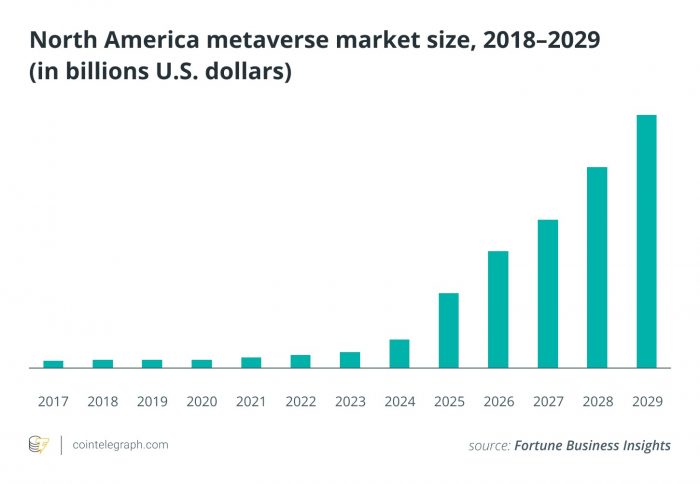Today, the metaverse is growing rapidly in terms of hype and the number of new project launches — so much so that the industry market size is expected to grow from $100.27 billion in 2022 to $1,527.55 billion in 2029. But how many of these new projects are even able to realize the actual vision set remotely?

Can Artificial Intelligence Help Realize Metaverse Visions?
We’re still a long way from seeing the true metaverse
Many of the metaverse projects that have been launched are in the gaming space. Often, however, these projects simply combine standard gaming features with virtual reality and NFTs. A true metaverse, in the sense of a digital parallel universe of our simulated world, a digitally simulated reality in which a participant can participate in various social, economic, recreational and artistic activities in various self-organized groups and environments, has not yet been realized .
Achieving this full vision requires easy portability for users, a large number of different pieces of the metaverse, and simple user building of new places and spaces – we’re still developing technology for this vision.
An underrated fact about Metaverse is that it fundamentally needs to embed artificial intelligence at its core in order to provide a lasting user value proposition. Mark Zuckerberg is well aware of this, but most people entering the crypto world are not AI-oriented. But how exactly will AI improve the metaverse?
Solving the “Sparsely Populated Metaverse” Problem
Competition among developers will allow early adopters to enter a sparsely populated world—a problem that AI can solve.
Metaverse presents a huge opportunity for new and existing tech companies to expand their offerings and create new revenue streams. There are currently over 160 companies developing their own worlds – each competing to be the leading metaverse supplier. It’s unlikely that we will have “one vendor to rule them all”, but rather a plethora of options at our disposal, each with their own unique offerings.
The benefit of this is a more diverse environment for end users, who will be able to choose from a variety of experiences. The downside is that with so many platforms vying for user attention and offering so many different experiences, the various meta domains will be very scarce early on. Because interacting with the metaverse is an inherently social experience, this raises a huge question.
AI-driven non-player characters can greatly help solve sparsely populated virtual worlds. Becoming one of the first users of a new world can be momentary—but if there’s no one to interact with and no one to do interesting things, it quickly loses its appeal. A society where AI characters build, talk, play music, create art, and buy and sell can turn a virtual ghost town into a shimmering hotbed of digital activity.
This will result in countless living worlds, which will inspire more people to join the metaverse – eventually reaching a point where non-player characters (NPCs) will be a bonus, not a necessity.
Guide users through the metaverse
Since many tech companies are developing their own metaverses, users not only need to be able to choose who they want to interact with, but they also need to be able to move seamlessly between each individual metaverse. Therefore, blockchain will be an important tool. Blockchain allows for easy transfers between all the small, manageable chunks of data that make up the shards of the blockchain network. This feature of the technology will allow users to easily move between each unique meta-domain. However, there is another problem with moving between worlds: users need to be aware of each new world they enter.
It is predicted that by 2026, 25% of people will use the Metaverse every day. From first-time users who need a comprehensive introduction, to jumping between tech-savvy worlds, everyone needs guidance in every new metaworld they spend their time in.
With such a large population spanning different worlds, it would be impossible for humans to manage the necessary number of introductions. The most effective way to introduce users to each metaverse is to use an AI guide. The tour guide will be able to explain to the user all the information needed in the personal world, ensuring the best user experience.
Building a truly digital world
Perhaps the most profound benefit AI will bring to the metaverse is in the realm of world-building. AI providers will be able to use neural networks (the processing power behind artificial intelligence), neurosymbolic AI (artificial intelligence techniques with advanced learning capabilities) and related technologies to generate custom scenarios for each user. This can be achieved by having the user describe some details about the desired scenario, and then having the AI generate a full description of said scenario.
The provider can then use another neural network that takes the spoken description of the input and brings it to life using virtual reality technology. Then putting these two neural models together, we get a system that takes partial recommendations from the user about potential scenarios and automatically launches a full VR experience, incorporating and extending the user’s recommendations.
This will be fine-tuned over time as more scenes are produced. Once there is a large enough community of users to leverage these capabilities to create unique content, AI can be used to data mine it all – finding common patterns, then using these to generate additional material and bias its users towards guiding content style creation.
Realistic and unrealistic scenarios can then be inferred from the popular human mind and guided using an interactive storytelling interface that lets each user choose the unique scenario they want to experience. Artificial intelligence will eventually be used to create immersive content in the metaverse.
All of these use cases point to the urgent need for AI services that work in tandem with VR and blockchain technology. As the metaverse grows in popularity, we’ll see an influx of money — helping to create the technology needed. With the proper deployment of AI technologies, they will unlock the true potential of the metaverse, and we will see the development of an exciting digital landscape that goes hand in hand with our analog world.




GIPHY App Key not set. Please check settings